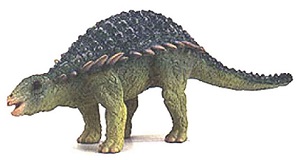
Pawpawsaurus Dinosaur a member of the nodosaurid group, thrived during the Early Cretaceous period, approximately 125 million years ago. This epoch was characterized by shifting continents, changing climates, and the emergence of new species in a world vastly different from our own.
One of Pawpawsaurus' most striking features was its armor. Covered in bony plates and spikes, these formidable defenses provided protection against potential predators and may have also served in temperature regulation. This armor, akin to that of its relatives like Sauropelta and Edmontonia, showcases the evolutionary adaptations that enabled certain dinosaurs to survive in their prehistoric environments.
| Name: | Pawpawsaurus dinosaurs |
| Size: | Around 13-15 feet. |
| Main Facts: | Pawpawsaurus,an Early Cretaceous armored dinosaur, boasted protective bony plates and spikes, contributing to its unique appearance and survival strategy. |
The fossil record of Pawpawsaurus is centered in North America, particularly in regions like Texas. These discoveries have allowed paleontologists to reconstruct the dinosaur's appearance and behavior. Analyzing its bones, osteoderms, and other skeletal features has provided a comprehensive understanding of Pawpawsaurus' place in the prehistoric world.

One of the fascinating aspects of Pawpawsaurus is its potential interactions with contemporaneous species. Sharing its habitat with a variety of dinosaurs, such as sauropods and theropods, offers glimpses into the complex interactions and dynamics of Early Cretaceous ecosystems. This interplay of herbivores, predators, and other species paints a vivid picture of life during this ancient time.
Pawpawsaurus' armor and skeletal features also offer insights into the broader evolutionary story of armored dinosaurs. Comparisons with other nodosaurids and ankylosaurs shed light on the variations in armor design, locomotion, and feeding strategies among these remarkable creatures.
Pawpawsaurus, an armored dinosaur of the Early Cretaceous, featured bony plates and spikes for protection. Measuring around 13 to 15 feet in length, it was herbivorous and played a crucial role in its ecosystem. Fossils found in North America, particularly Texas, provide insights into its appearance and behavior.
Sharing its habitat with various dinosaurs, Pawpawsaurus offers glimpses into the intricate interactions of prehistoric ecosystems. Its armor and skeletal features contribute to our understanding of the evolution and diversity of armored dinosaurs. As a testament to the ancient world, Pawpawsaurus continues to intrigue researchers and enthusiasts alike, shedding light on the wonders of Earth's prehistoric past.
Pawpawsaurus' bony plates and spikes distinguish it from ankylosaurs like Ankylosaurus, showcasing different approaches to protective armor.
Pawpawsaurus' estimated size, around 13-15 feet, contrasts with larger dinosaurs like sauropods, highlighting diverse body forms.
Pawpawsaurus' plant-based diet aligns it with other herbivores like hadrosaurs, emphasizing varying feeding strategies.
Fossil evidence places Pawpawsaurus in North America, similar to other Cretaceous dinosaurs like Triceratops, suggesting regional habitats.
Comparing Pawpawsaurus' armor to the plated dinosaurs, like Stegosaurus, reveals adaptations for defense and potential thermoregulation.
Pawpawsaurus coexisted with diverse dinosaurs like theropods and sauropods, offering insights into interactions within Early Cretaceous ecosystems.
Comparing Pawpawsaurus' bones with those of similar dinosaurs helps uncover variations in locomotion, posture, and feeding habits.
Pawpawsaurus' armor and spikes contrast with the camouflaging strategies of some ornithopods, illustrating different survival tactics.